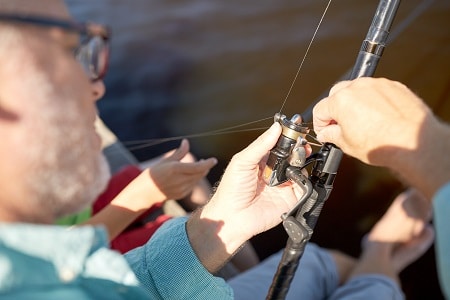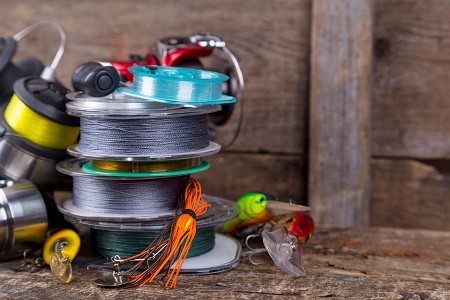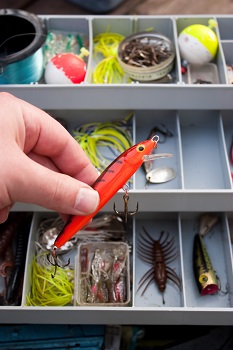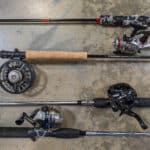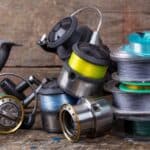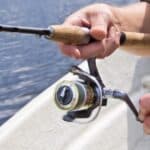It’s always more fun to fish than it is to futz around with your gear, but some types of maintenance are unavoidable. For example, you have to change your line periodically to ensure that a big fish doesn’t snap off your line and break your heart.
Fortunately, spooling your reel with a fresh line is an easy task especially for anglers who use spinning reels. You don’t need any tools other than a pair of line cutters, and the entire job can be completed in less than 10 minutes.
Stringing Line on Your Reel
The following seven steps will help you string your reel properly and enjoy problem-free operation.
Step 1
Hold the reel in your hand as though you were fishing. Crank the reel a few times and observe which direction the reel turns while you are cranking.
Step 2
Open the bail and remove all the old line if necessary. Thread the new line through the guides on your rod and tie it to the spool with an arbor knot.
Trim away the excess line from the knot with a pair of scissors or line cutters (you want to leave about ¼-inch of the line extending beyond the knot).
Step 3
Place the spool of the new line flat on the floor. Orient it so that the line comes off in the same direction that it will go onto the reel’s spool to help avoid problems with line twist.
If, for example, the line doesn’t come off correctly with the label-side of the supply spool facing up, flip it over.
Step 4
Lightly pinch the line about 12 inches above the reel and keep it taught. Slowly begin cranking the reel while letting the line slide through your fingers. Stop after cranking the reel about 20 times and inspect the line for twists.
If the line is twisting, you need to strip some of the line back off your reel and flip the spool of a fresh line over to the other side.
Step 5
Once you are sure that the line is not twisting, you can continue cranking the reel and loading the spool with line. Just be sure to stop every so often and check for line twist.
Step 6
Stop adding line once it comes within 1/8 of an inch of the spool’s rim.
This ensures that you have plenty of line on your reel (even if you need to cut off a significant portion as you change lures and deal with the occasional snag), without overloading the reel, which often leads to tangles.
Step 7
Once the reel has been spooled, cut the line off near the supply spool. Tie a lure, swivel or clip onto the free end of the line to prevent it from slipping through the guides.
Be sure to tape the open end of the supply spool in place so it won’t unravel while bouncing around in your tackle box.
Selecting the Best Line for Your Needs
Of course, you’ll have better fishing success if you use a line well-suited for your gear and fishing style.
Lines made from different materials and in various ways work better for some situations than others do so it is important that you select the best one for your circumstances.
Types of Line
There are a number of materials and methods used to create modern fishing lines, and each has different strengths and weaknesses. Although there are exceptions, most lines fall into one of the three categories detailed below.
Monofilament
Monofilament lines are single-strand lines, typically made from nylon. They are usually the least expensive of the three primary line types and they’ve been in use for longer than the other two.
It stretches quite a bit which can make it difficult to set the hook (especially during long casts). However, this is also helpful when fishing treble-hook-laden lures, as the additional flexibility helps prevent the hooks from pulling free from the fish’s mouth.
Braided
Braided lines, as their name implies, are comprised of several lengths of material (usually synthetic materials such as Dacron or Spectra) that have been braided together to create a single line.
It can be difficult to cast your lures as far with braided lines as you can with monofilament or fluorocarbon lines, but they offer plenty of benefits.
For example, braided lines hardly stretch at all and their durability is unmatched. They sink slowly, making it an excellent choice for those fishing topwater baits.
Fluorocarbon
Fluorocarbon lines are the newest of the three basic line types, and they’ve quickly become a favorite choice among many anglers.
Note that they are also “monofilament” lines as they’re made from a single strand. But in practice, this term is used almost exclusively to refer to nylon monofilament lines.
Fluorocarbon lines are very difficult for fish to see underwater, they stretch less than monofilament lines do and they are moderately resistant to abrasion.
Selecting The Correct Line Diameter
Once you’ve decided on the type of line you’d like to use, you must determine what diameter you need.
Fishing lines are made in varying diameters which roughly correspond with their strength. The thicker the line, the stronger it is relative to thinner lines made from the same material.
However, instead of labeling lines by diameter, most manufacturers label their lines by the amount of weight they can support. For example, a line labeled as 12-pound-test supports approximately 12 pounds of weight.
Accordingly, you’ll always want to use a line strong enough to support the weight of the fish you are likely to catch.
You don’t want to target striped bass with 4-pound-test line, as many of the fish you’ll catch will break your line without even trying. However, you don’t want to use a line that is heavier than necessary as this can alter the way your lures behave.
Lure
The lure you intend to use plays a major role in your line choice. Most anglers like to use the lightest line possible – usually in the 6- to 10-pound-test range — when fishing finesse-style lures such as jerk baits and small soft plastic lures.
Conversely, many anglers using topwater lures like to use very heavy line — 65-pound-test braided lines are one of the most common choices for anglers fishing floating frogs.
Spinnerbaits, crankbaits, swimbaits, and similar lures usually work best with an average line diameter, typically in the 8- to 12-pound-test neighborhood.
Just be sure that you follow the line recommendations provided by the manufacturer of your rod and reel – these guidelines are often printed on the rod and reel.
You don’t want to use a line that is too strong for your rod, or you might end up snapping the rod in half. Conversely, you can accidentally break your line while setting the hook if you use one that is too weak for your rod’s rating.
Share Your Thoughts
Do you have any helpful tips for spooling your spinning reel or choosing the best line for your needs? We’d love to hear your thoughts in the comments below.
Tell us about your favorite type of fishing line and explain what you like about it.


